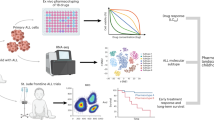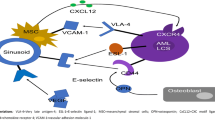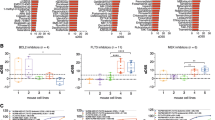Abstract
Purpose
Although high-dose, multiagent chemotherapy has improved leukemia survival rates, treatment outcomes remain poor in high-risk subsets, including acute myeloid leukemia (AML) and acute lymphoblastic leukemia (ALL) in infants. The development of new, more effective therapies for these patients is therefore an urgent, unmet clinical need.
Methods
The dual MERTK/FLT3 inhibitor MRX-2843 and BCL-2 family protein inhibitors were screened in high-throughput against a panel of AML and MLL-rearranged precursor B-cell ALL (infant ALL) cell lines. A neural network model was built to correlate ratiometric drug synergy and target gene expression. Drugs were loaded into liposomal nanocarriers to assess primary AML cell responses.
Results
MRX-2843 synergized with venetoclax to reduce AML cell density in vitro. A neural network classifier based on drug exposure and target gene expression predicted drug synergy and growth inhibition in AML with high accuracy. Combination monovalent liposomal drug formulations delivered defined drug ratios intracellularly and recapitulated synergistic drug activity. The magnitude and frequency of synergistic responses were both maintained and improved following drug formulation in a genotypically diverse set of primary AML bone marrow specimens.
Conclusions
We developed a nanoscale combination drug formulation that exploits ectopic expression of MERTK tyrosine kinase and dependency on BCL-2 family proteins for leukemia cell survival in pediatric AML and infant ALL cells. We demonstrate ratiometric drug delivery and synergistic cell killing in AML, a result achieved by a systematic, generalizable approach of combination drug screening and nanoscale formulation that may be extended to other drug pairs or diseases in the future.





Similar content being viewed by others
Data Availability
Data will be made available on request.
References
Pieters R, De Lorenzo P, Ancliffe P, Aversa LA, Brethon B, Biondi A, et al. Outcome of Infants Younger Than 1 Year With Acute Lymphoblastic Leukemia Treated With the Interfant-06 Protocol: Results From an International Phase III Randomized Study. Journal of clinical oncology : official journal of the American Society of Clinical Oncology. 2019;37(25):2246–56.
Siegel RL, Miller KD, Fuchs HE, Jemal A. Cancer statistics, 2022. CA: A Cancer Journal for Clinicians. 2022;72(1):7-33.
Dreyer ZE, Hilden JM, Jones TL, Devidas M, Winick NJ, Willman CL, et al. Intensified chemotherapy without SCT in infant ALL: results from COG P9407 (Cohort 3). Pediatric blood & cancer. 2015;62(3):419–26.
Gaynon PS, Angiolillo AL, Carroll WL, Nachman JB, Trigg ME, Sather HN, et al. Long-term results of the children’s cancer group studies for childhood acute lymphoblastic leukemia 1983–2002: A Children’s Oncology Group Report. Leukemia. 2010;24(2):285–97.
Gorman MF, Ji L, Ko RH, Barnette P, Bostrom B, Hutchinson R, et al. Outcome for children treated for relapsed or refractory acute myelogenous leukemia (rAML): a Therapeutic Advances in Childhood Leukemia (TACL) Consortium study. Pediatric blood & cancer. 2010;55(3):421–9.
Zarnegar-Lumley S, Caldwell KJ, Rubnitz JE. Relapsed acute myeloid leukemia in children and adolescents: current treatment options and future strategies. Leukemia. 2022;36(8):1951–60.
Rubnitz JE, Kaspers GJL. How I treat pediatric acute myeloid leukemia. Blood. 2021;138(12):1009–18.
Choi KY, Correa S, Min J, Li J, Roy S, Laccetti KH, et al. Binary Targeting of siRNA to Hematologic Cancer Cells In Vivo using Layer-by-Layer Nanoparticles. Advanced functional materials. 2019;29(20).
Deng ZJ, Morton SW, Ben-Akiva E, Dreaden EC, Shopsowitz KE, Hammond PT. Layer-by-layer nanoparticles for systemic codelivery of an anticancer drug and siRNA for potential triple-negative breast cancer treatment. ACS nano. 2013;7(11):9571–84.
Detappe A, Nguyen HV, Jiang Y, Agius MP, Wang W, Mathieu C, et al. Molecular bottlebrush prodrugs as mono- and triplex combination therapies for multiple myeloma. Nature nanotechnology. 2023.
Do P, Perdue LA, Chyong A, Hunter R, Dougan J, Henry CJ, et al. Rapid Assembly and Screening of Multivalent Immune Cell-Redirecting Therapies for Leukemia. ACS combinatorial science. 2020;22(10):533–41.
Dreaden EC, Kong YW, Morton SW, Correa S, Choi KY, Shopsowitz KE, et al. Tumor-Targeted Synergistic Blockade of MAPK and PI3K from a Layer-by-Layer Nanoparticle. Clinical cancer research : an official journal of the American Association for Cancer Research. 2015;21(19):4410–9.
Goldman A, Kulkarni A, Kohandel M, Pandey P, Rao P, Natarajan SK, et al. Rationally Designed 2-in-1 Nanoparticles Can Overcome Adaptive Resistance in Cancer. ACS nano. 2016;10(6):5823–34.
Houdaihed L, Evans JC, Allen C. In Vivo Evaluation of Dual-Targeted Nanoparticles Encapsulating Paclitaxel and Everolimus. Cancers (Basel). 2019;11(6).
Kong YW, Dreaden EC, Morandell S, Zhou W, Dhara SS, Sriram G, et al. Enhancing chemotherapy response through augmented synthetic lethality by co-targeting nucleotide excision repair and cell-cycle checkpoints. Nat Commun. 2020;11(1):4124.
Mikhail AS, Eetezadi S, Allen C. Multicellular tumor spheroids for evaluation of cytotoxicity and tumor growth inhibitory effects of nanomedicines in vitro: a comparison of docetaxel-loaded block copolymer micelles and Taxotere®. PloS one. 2013;8(4): e62630.
Morton SW, Lee MJ, Deng ZJ, Dreaden EC, Siouve E, Shopsowitz KE, et al. A nanoparticle-based combination chemotherapy delivery system for enhanced tumor killing by dynamic rewiring of signaling pathways. Science signaling. 2014;7(325):ra44.
Sengupta S, Eavarone D, Capila I, Zhao G, Watson N, Kiziltepe T, et al. Temporal targeting of tumour cells and neovasculature with a nanoscale delivery system. Nature. 2005;436(7050):568–72.
Kaspers GJ, Zimmermann M, Reinhardt D, Gibson BE, Tamminga RY, Aleinikova O, et al. Improved outcome in pediatric relapsed acute myeloid leukemia: results of a randomized trial on liposomal daunorubicin by the International BFM Study Group. Journal of clinical oncology : official journal of the American Society of Clinical Oncology. 2013;31(5):599–607.
Cooper TM, Absalon MJ, Alonzo TA, Gerbing RB, Leger KJ, Hirsch BA, et al. Phase I/II Study of CPX-351 Followed by Fludarabine, Cytarabine, and Granulocyte-Colony Stimulating Factor for Children With Relapsed Acute Myeloid Leukemia: A Report From the Children’s Oncology Group. Journal of clinical oncology : official journal of the American Society of Clinical Oncology. 2020;38(19):2170–7.
Minson KA, Smith CC, DeRyckere D, Libbrecht C, Lee-Sherick AB, Huey MG, et al. The MERTK/FLT3 inhibitor MRX-2843 overcomes resistance-conferring FLT3 mutations in acute myeloid leukemia. JCI Insight. 2016;1(3): e85630.
Zhang W, DeRyckere D, Hunter D, Liu J, Stashko MA, Minson KA, et al. UNC2025, a potent and orally bioavailable MER/FLT3 dual inhibitor. Journal of medicinal chemistry. 2014;57(16):7031–41.
Campos L, Rouault JP, Sabido O, Oriol P, Roubi N, Vasselon C, et al. High expression of bcl-2 protein in acute myeloid leukemia cells is associated with poor response to chemotherapy. Blood. 1993;81(11):3091–6.
Delia D, Aiello A, Soligo D, Fontanella E, Melani C, Pezzella F, et al. bcl-2 proto-oncogene expression in normal and neoplastic human myeloid cells. Blood. 1992;79(5):1291–8.
Karakas T, Maurer U, Weidmann E, Miething CC, Hoelzer D, Bergmann L. High expression of bcl-2 mRNA as a determinant of poor prognosis in acute myeloid leukemia. Annals of oncology : official journal of the European Society for Medical Oncology. 1998;9(2):159–65.
Tóthová E, Fricova M, Stecová N, Kafková A, Elbertová A. High expression of Bcl-2 protein in acute myeloid leukemia cells is associated with poor response to chemotherapy. Neoplasma. 2002;49(3):141–4.
Lauria F, Raspadori D, Rondelli D, Ventura MA, Fiacchini M, Visani G, et al. High bcl-2 expression in acute myeloid leukemia cells correlates with CD34 positivity and complete remission rate. Leukemia. 1997;11(12):2075–8.
Konopleva M, Pollyea DA, Potluri J, Chyla B, Hogdal L, Busman T, et al. Efficacy and Biological Correlates of Response in a Phase II Study of Venetoclax Monotherapy in Patients with Acute Myelogenous Leukemia. Cancer discovery. 2016;6(10):1106–17.
DiNardo CD, Pratz K, Pullarkat V, Jonas BA, Arellano M, Becker PS, et al. Venetoclax combined with decitabine or azacitidine in treatment-naive, elderly patients with acute myeloid leukemia. Blood. 2019;133(1):7–17.
DiNardo CD, Pratz KW, Letai A, Jonas BA, Wei AH, Thirman M, et al. Safety and preliminary efficacy of venetoclax with decitabine or azacitidine in elderly patients with previously untreated acute myeloid leukaemia: a non-randomised, open-label, phase 1b study. The Lancet Oncology. 2018;19(2):216–28.
Lagunas-Rangel FA, Chávez-Valencia V. FLT3-ITD and its current role in acute myeloid leukaemia. Medical oncology (Northwood, London, England). 2017;34(6):114.
Daver N, Schlenk RF, Russell NH, Levis MJ. Targeting FLT3 mutations in AML: review of current knowledge and evidence. Leukemia. 2019;33(2):299–312.
Qiu KY, Liao XY, Liu Y, Huang K, Li Y, Fang JP, et al. Poor outcome of pediatric patients with acute myeloid leukemia harboring high FLT3/ITD allelic ratios. NATURE COMMUNICATIONS. 2022;13(1).
Cuglievan B, McCall D, Robusto L, Mireles ME, Gettys SC. Current and emerging pharmacotherapy for the treatment of childhood acute myeloid leukemia. Expert opinion on pharmacotherapy. 2022;23(17):1915–25.
Wu XL, Feng XF, Zhao XQ, Ma FT, Liu N, Guo HM, et al. Prognostic significance of FLT3-ITD in pediatric acute myeloid leukemia: a meta-analysis of cohort studies. MOLECULAR AND CELLULAR BIOCHEMISTRY. 2016;420(1–2):121–8.
Brinton LT, Zhang P, Williams K, Canfield D, Orwick S, Sher S, et al. Synergistic effect of BCL2 and FLT3 co-inhibition in acute myeloid leukemia. Journal of Hematology & Oncology. 2020;13(1):139.
Guttridge KL, Christopher Luft J, Dawson TL, Kozlowska E, Mahajan NP, Varnum B, et al. Mer receptor tyrosine kinase signaling: Prevention of apoptosis and alteration of cytoskeletal architecture without stimulation or proliferation. Journal of Biological Chemistry. 2002;277(27):24057–66.
Huelse JM, Fridlyand DM, Earp S, DeRyckere D, Graham DK. MERTK in cancer therapy: Targeting the receptor tyrosine kinase in tumor cells and the immune system. Pharmacology & therapeutics. 2020;213: 107577.
Lee-Sherick AB, Eisenman KM, Sather S, McGranahan A, Armistead PM, McGary CS, et al. Aberrant Mer receptor tyrosine kinase expression contributes to leukemogenesis in acute myeloid leukemia. Oncogene. 2013;32(46):5359–68.
Linger RM, Lee-Sherick AB, DeRyckere D, Cohen RA, Jacobsen KM, McGranahan A, et al. Mer receptor tyrosine kinase is a therapeutic target in pre-B-cell acute lymphoblastic leukemia. Blood. 2013;122(9):1599–609.
Linger RMA, Cohen RA, Cummings CT, Sather S, Migdall-Wilson J, Middleton DHG, et al. Mer or Axl receptor tyrosine kinase inhibition promotes apoptosis, blocks growth and enhances chemosensitivity of human non-small cell lung cancer. Oncogene. 2013;32(29):3420–31.
Paugh SW, Stocco G, Evans WE. Pharmacogenomics in pediatric leukemia. Current opinion in pediatrics. 2010;22(6):703–10.
Berenbaum MC. What is synergy? Pharmacological Reviews. 1989;41(2):93–141.
BLISS CI. THE TOXICITY OF POISONS APPLIED JOINTLY1. Annals of Applied Biology. 1939;26(3):585-615.
Greco WR, Bravo G, Parsons JC. The search for synergy: a critical review from a response surface perspective. Pharmacol Rev. 1995;47(2):331–85.
Foucquier J, Guedj M. Analysis of drug combinations: current methodological landscape. Pharmacology research & perspectives. 2015;3(3): e00149.
Geary N. Understanding synergy. American journal of physiology Endocrinology and metabolism. 2013;304(3):E237-53.
Slinker BK. The statistics of synergism. Journal of molecular and cellular cardiology. 1998;30(4):723–31.
Wallin JJ, Guan J, Prior WW, Lee LB, Berry L, Belmont LD, et al. GDC-0941, a novel class I selective PI3K inhibitor, enhances the efficacy of docetaxel in human breast cancer models by increasing cell death in vitro and in vivo. Clinical cancer research : an official journal of the American Association for Cancer Research. 2012;18(14):3901–11.
F.R.S. KP. LIII. On lines and planes of closest fit to systems of points in space. Philosophical Magazine Series 1. 1901;2:559-72.
Greenacre M, Groenen PJF, Hastie T, D’Enza AI, Markos A, Tuzhilina E. Principal component analysis. Nature Reviews Methods Primers. 2022;2(1):100.
Hotelling H. Analysis of a complex of statistical variables into principal components. Journal of Educational Psychology. 1933;24:498–520.
Barretina J, Caponigro G, Stransky N, Venkatesan K, Margolin AA, Kim S, et al. The Cancer Cell Line Encyclopedia enables predictive modelling of anticancer drug sensitivity. Nature. 2012;483(7391):603–7.
Greener JG, Kandathil SM, Moffat L, Jones DT. A guide to machine learning for biologists. Nature reviews Molecular cell biology. 2022;23(1):40–55.
Tarca AL, Carey VJ, Chen XW, Romero R, Drăghici S. Machine learning and its applications to biology. PLoS computational biology. 2007;3(6): e116.
White H. Learning in Artificial Neural Networks: A Statistical Perspective. Neural Computation. 1989;1(4):425–64.
Zhang P. Neural Networks for Classification: A Survey. Systems, Man, and Cybernetics, Part C: Applications and Reviews, IEEE Transactions on. 2000;30:451–62.
Inc. SI. JMP(R) 16 Documentation Library. 2020-2021.
Eisenmann ED, Jin Y, Weber RH, Sparreboom A, Baker SD. Development and validation of a sensitive UHPLC-MS/MS analytical method for venetoclax in mouse plasma, and its application to pharmacokinetic studies. Journal of chromatography B, Analytical technologies in the biomedical and life sciences. 2020;1152: 122176.
Pokar D, Sahu AK, Sengupta P. LC-Q-TOF-MS driven identification of potential degradation impurities of venetoclax, mechanistic explanation on degradation pathway and establishment of a quantitative analytical assay method. Journal of Analytical Science and Technology. 2020;11(1):54.
Klco JM, Spencer DH, Lamprecht TL, Sarkaria SM, Wylie T, Magrini V, et al. Genomic impact of transient low-dose decitabine treatment on primary AML cells. Blood. 2013;121(9):1633–43.
Lee-Sherick AB, Zhang W, Menachof KK, Hill AA, Rinella S, Kirkpatrick G, et al. Efficacy of a Mer and Flt3 tyrosine kinase small molecule inhibitor, UNC1666, in acute myeloid leukemia. Oncotarget. 2015;6(9):6722–36.
Nguyen M, Cencic R, Ertel F, Bernier C, Pelletier J, Roulston A, et al. Obatoclax is a direct and potent antagonist of membrane-restricted Mcl-1 and is synthetic lethal with treatment that induces Bim. BMC cancer. 2015;15:568.
Lessene G, Czabotar PE, Colman PM. BCL-2 family antagonists for cancer therapy. Nature reviews Drug discovery. 2008;7(12):989–1000.
Janssen M, Schmidt C, Bruch P-M, Blank M, Rohde C, Waclawiczek A, et al. Venetoclax synergizes with gilteritinib in FLT3 wild-type high-risk acute myeloid leukemia by suppressing MCL-1. Blood. 2022;140(24):2594–610.
Post SM, Ma H, Malaney P, Zhang X, Aitken MJL, Mak PY, et al. AXL/MERTK inhibitor ONO-7475 potently synergizes with venetoclax and overcomes venetoclax resistance to kill FLT3 -ITD acute myeloid leukemia. Haematologica. 2021;107(6):1311–22.
Ma J, Zhao S, Qiao X, Knight T, Edwards H, Polin L, et al. Inhibition of Bcl-2 Synergistically Enhances the Antileukemic Activity of Midostaurin and Gilteritinib in Preclinical Models of FLT3-Mutated Acute Myeloid Leukemia. Clinical Cancer Research. 2019;25(22):6815–26.
Graham DK, DeRyckere D, Davies KD, Earp HS. The TAM family: phosphatidylserine sensing receptor tyrosine kinases gone awry in cancer. Nature reviews Cancer. 2014;14(12):769–85.
Crommelin DJA, van Hoogevest P, Storm G. The role of liposomes in clinical nanomedicine development. What now? Now what? Journal of Controlled Release. 2020;318:256-63.
van Hoogevest P, Tiemessen H, Metselaar JM, Drescher S, Fahr A. The Use of Phospholipids to Make Pharmaceutical Form Line Extensions. European Journal of Lipid Science and Technology. 2021;123(4):2000297.
Krauss AC, Gao X, Li L, Manning ML, Patel P, Fu W, et al. FDA Approval Summary: (Daunorubicin and Cytarabine) Liposome for Injection for the Treatment of Adults with High-Risk Acute Myeloid Leukemia. Clinical cancer research : an official journal of the American Association for Cancer Research. 2019;25(9):2685–90.
Lim WS, Tardi PG, Dos Santos N, Xie X, Fan M, Liboiron BD, et al. Leukemia-selective uptake and cytotoxicity of CPX-351, a synergistic fixed-ratio cytarabine:daunorubicin formulation, in bone marrow xenografts. Leukemia research. 2010;34(9):1214–23.
Wang Q, Tardi P, Sadowski N, Xie S, Heller D, Mayer L. Pharmacokinetics, drug metabolism, and tissue distribution of CPX-351 in animals. Nanomedicine : nanotechnology, biology, and medicine. 2020;30: 102275.
Large DE, Abdelmessih RG, Fink EA, Auguste DT. Liposome composition in drug delivery design, synthesis, characterization, and clinical application. Advanced drug delivery reviews. 2021;176: 113851.
Cucchi DGJ, Groen RWJ, Janssen J, Cloos J. Ex vivo cultures and drug testing of primary acute myeloid leukemia samples: Current techniques and implications for experimental design and outcome. Drug resistance updates : reviews and commentaries in antimicrobial and anticancer chemotherapy. 2020;53: 100730.
Acknowledgements
We are grateful for assistance from the Pediatric General Equipment Core, the Robert P. Apkarian Integrated Electron Microscopy Core, the Emory University Lipidomics Core, the Emory University School of Medicine Flow Cytometry Core, the Georgia Institute of Technology Systems Mass Spectrometry Core Facility, and the Emory Chemical Biology Discovery Center. Patient samples were provided by the Aflac Leukemia and Lymphoma Biorepository at Children’s Healthcare of Atlanta; other investigators may have received specimens from the same subjects. The content here is solely the responsibility of the authors and does not necessarily represent the official views of the organizations acknowledged herein.
Funding
This work was supported in part by a research grant from CURE Childhood Cancer (DD), the National Institutes of Health Research Training Program in Immunoengineering (T32EB021962) and the Coulter Department of Biomedical Engineering.
CURE Childhood Cancer,NIH Research Training Program in Immunoengineering,T32EB021962,Lacey A Birnbaum ,Wallace H. Coulter Department of Biomedical Engineering
Author information
Authors and Affiliations
Contributions
J.M.K., J.J., A.T., R.J.S., X.W., N.T.J., H.F., Y.D., D.D., D.K.G., and E.C.D. designed research; J.M.K., J.J., A.T., M.Q., L.A.B., S.G.M., H.Z., J.M.S, E.C., and B.U. performed research or analyzed data; J.M.K., J.J., Y.D., D.D., D.K.G., and E.C.D. wrote or edited the manuscript.
Corresponding authors
Ethics declarations
Competing interests
D.K.G. is a founder and serves on the Board of Directors of Meryx, Inc. X.W., D.D., and D.K.G. are equity holders in Meryx, Inc. X.W. is an inventor on patents describing MRX-2843. J.M.K., J.J., D.D., D.K.G., and E.C.D. are inventors on a patent describing combination drug nanoformulations related to this work.
Additional information
Publisher's Note
Springer Nature remains neutral with regard to jurisdictional claims in published maps and institutional affiliations.
Supplementary Information
Below is the link to the electronic supplementary material.
Rights and permissions
Springer Nature or its licensor (e.g. a society or other partner) holds exclusive rights to this article under a publishing agreement with the author(s) or other rightsholder(s); author self-archiving of the accepted manuscript version of this article is solely governed by the terms of such publishing agreement and applicable law.
About this article
Cite this article
Kelvin, J.M., Jain, J., Thapa, A. et al. Constitutively Synergistic Multiagent Drug Formulations Targeting MERTK, FLT3, and BCL-2 for Treatment of AML. Pharm Res 40, 2133–2146 (2023). https://doi.org/10.1007/s11095-023-03596-9
Received:
Accepted:
Published:
Issue Date:
DOI: https://doi.org/10.1007/s11095-023-03596-9




